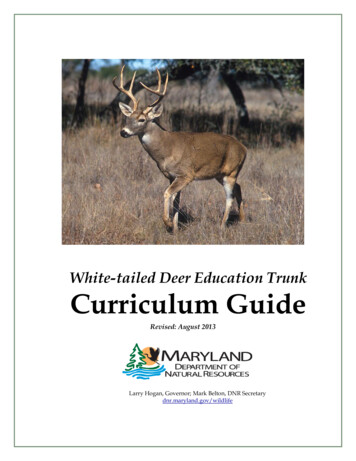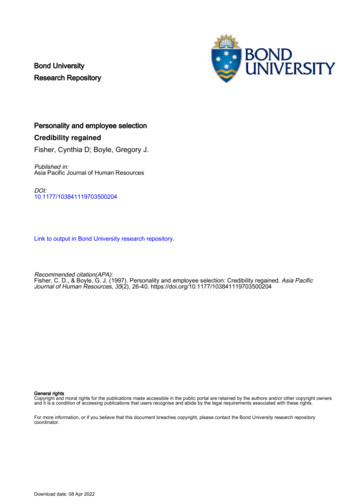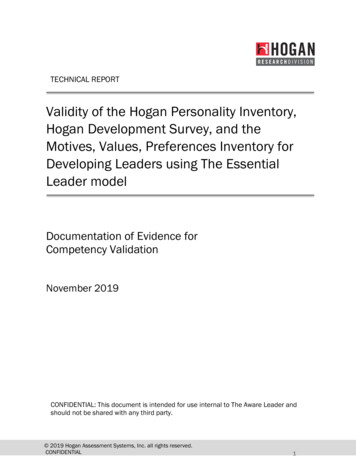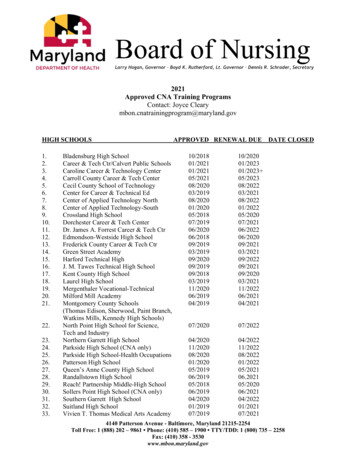
Transcription
White-tailed Deer Education TrunkCurriculum GuideRevised: August 2013Larry Hogan, Governor; Mark Belton, DNR Secretarydnr.maryland.gov/wildlife
Table of ContentsSection 1: White-tailed Deer Ecology1. White-tailed Deer Quick Facts .pg 22. White-tailed Deer Fact Sheet .pg 43. White-tailed Deer Adaptations pg 8Section 2: White-tailed Deer Management1. White-tailed Deer Management Timeline .pg 142. History of White-tailed Deer Management in Maryland . .pg 163. Modern White-tailed Deer Management in Maryland . .pg 224. White-tailed Deer Management Techniques .pg 28Section 3: Activity Lesson Plans1. Maryland Environmental Literacy Alignments . .pg 362. Activity: Project WILD: Make a Coat (Grades K-4) . .pg 393. Activity: Project WILD: Everybody Needs a Home (Grades K-4) . .pg 424. Activity: Where is the Tooth Fairy? (Grades 2-3) .pg 445. Activity: Project WILD: Quick, Frozen Critters (Grades 5-8) . .pg 486. Activity: Project WILD: Oh, Deer! (Grades 5-8) . . pg 527. Activity: Project WILD: Tracks! (Grades 5-8) . .pg 578. Activity: Project WILD: Deer Crossing (Grades 9-12) . pg 629. Activity: Project WILD: Deer Dilemma (Grades 9-12) . pg 6510. Activity: Project WILD: Carrying Capacity (Grades 9-12) . pg 7211. Activity: White-tailed Deer Population Study (Grades 9-12) . pg 76Additional Activities:1. White-tailed Deer Quiz .pg 962. White-tailed Deer Crossword .pg 983. White-tailed Deer Word Search . .pg 1004. White-tailed Deer Fill-In-The-Blank . .pg 1025. White-tailed Deer Music & Movement . .pg 1046. White-tailed Deer Reading Activity pg 1057. What Animal Made These Tracks? .pg 1068. Deer Crafts . .pg 1089. Connect the Dots .pg 10910. Coloring Pages pg 11011. Deer Maze pg 113The facilities and services of the Maryland Department of Natural Resources are available to all without regard torace, color, religion, sex, sexual orientation, age, national origin or physical or mental disability.This document is available in an alternative format upon request from a qualified individual with a disability.dnr.maryland.gov410-260-8566; Toll Free in Maryland: 1-877-620-8DNR, ext.8566
Section 1:White-tailed Deer Ecology1
White-tailed Deer Quick Facts The white-tailed deer is the only deer species native to Maryland. Sika deer havebeen introduced.White-tailed deer have big eyes, sharp hearing and a keen sense of smell. Theircoats are reddish brown in the summer and grayish brown in the winter.Fawns are reddish brown with white spots which fade away. They have a whitetail which they flash back and forth when they run.A male white-tailed deer is called a buck, a female is called a doe and the youngare called fawns.Males grow antlers from March – September. The antlers are shed in late winter.On rare occasions, a female will grow antlers.White-tailed deer give birth to their fawns in May and June.White-tailed deer are 3-3 ½ feet at the shoulder and weigh 50-250 pounds. Malesare larger than females.White-tailed deer are herbivores and are characterized as browsers and grazers.They eat twigs, buds, and leaves of a wide variety of plants. They also feed onacorns, fruits, grasses and agricultural crops such as corn and soybeans.Deer are good jumpers and swimmers and can easily clear an 8-foot fence.White-tailed deer are very abundant and are found throughout Maryland inforests, farms, wetlands, parks, open areas, and suburban areas.When a white-tailed deer is startled, it may raise its tail to show the whiteunderside, hence the name white-tailed deer. When a mother raises her tail, ithelps to allow her fawn to follow her.Deer can run up to 35 mph.The lifespan of a deer can be up to 20 years in captivity .Deer antlers are the fastest growing bone known and can grow as much as a ½inch a day.2
White-tailed Deer TaxonomyTaxonomy is the science of identification, naming and classification of living organisms.Taxonomy uses a hierarchal structure that classifies organisms from very broadcategories to very specific categories. In terms of scientific classification, the broadestcategories are Kingdoms while the most specific ones are Species and Subspecies. Thefollowing information details the taxonomic classification of white-tailed pecies-virginianusThe Order Artiodactyla refers to even-toed hoofed mammals (aka ungulates). Theseanimals bore most of their weight on the third and fourth toes rather than on their thirdtoes like Perissodactyls such as horses. There are over 200 species of Artiodactylsworldwide including pigs, hippopotamuses, camels, antelopes, sheep, goats and cattle.The Family Cervidae, also known as the deer family, includes 47 species such asvarious types of deer, moose, elk (wapiti), caribou, and reindeer. Some deer species aresocial, but others are solitary. The earliest deer appeared during the late OligoceneEpoch, roughly 35 million years ago. The "Irish elk" Megaloceros was a large,prehistoric deer that had antlers that were 11 feet wide! The largest Cervid today is theMoose and the smallest is the Andean Pudu.The genus Odocoileus contains two medium-sized deer species native to the Americas.The name is from a contraction of the roots odonto- and coelus meaning "hollow-tooth".The white-tailed deer is the only Odocoileus species native to Maryland. The otherspecies in Odocoileus is the mule deer (Odocoileus hemionus) which is indigenous to thewestern half of North America. Mule deer and white-tailed deer have evolved fromprimitive deer of the genus Odocoileus. The white-tailed deer is the oldest species of thisfamily. It first appeared in the southern part of North America some 4 million yearsago.3
White-tailed Deer Fact Sheet(Odocoileus virginianus)Description and Range:Adult white-tailed deer are about three feet tall at the front shoulders. Marylandyearling bucks (males) weigh an average of 105 pounds; yearling does (females)average 90 pounds. During the warm months, deer possess reddish-brown hair. Agrayish-brown coat with a thick undercoat replaces the reddish hair during the coldtime period. The white-tailed deer’s distinctive white tail and white rump patch isreadily visible when they bound away from real or perceived danger. White-tailed deersprint up to 35 miles per hour and are able to leap over 8 foot tall barriers.Only white-tailed bucks possess antlers. In extremely rare cases, does may growantlers. Bucks use their hard antlers to establish dominance over other bucks duringbreeding season. Antlers are grown and shed each year. Antlers, which are composed oftrue bone, begin to grow in late March and early April. The growing antlers are coveredwith skin and blood vessels called velvet.White-tailed deer can be found in every county in Maryland. White-tailed deer are alsocommon throughout much of the United States, southern Canada and even parts ofcentral America.Doe (left) by John White and a buck with velvet antlers (right) by Kerry WixtedHabitat:Maryland white-tailed deer habitat includes most of the state except for open water andintensely developed urban areas (e.g. downtown Baltimore). Deer thrive in landscapeswith wooded/brush sections and open areas such as cropland, pasture or landscapedyards. Deer use the wooded areas for food and cover, and open areas provide food.Landscapes with an abundance of edge habitat (areas where forested and open habitat4
meet) are prime deer habitats. Because of this, suburban sprawl creates ideal habitatconditions for white-tailed deer. When forested areas or open farmland are convertedinto housing developments, portions are cleared for roads and home sites, while othersections remain forested. Both of these types of residential conversions provideexcellent deer habitat.The typical, annual average home range for white-tailed deer is considered about onesquare mile (640 acres). However, the sex and age of the deer and habitat types willinfluence varying size home ranges. Yearling males will move many miles while adultfemales usually have smaller stable, annual home ranges. Deer in good quality habitatwill need to travel less than deer in poor quality habitat.Diet:Deer feed on nuts and berries, leaves, woody shoots and stems, grasses and cultivatedcrops. Some of their favorite natural foods include acorns, honeysuckle, poison ivy,green briar, young tree seedlings and mushrooms. Soybeans, corn and ornamentalshrubs are several of their favorite foods planted by humans.Deer have a four-chambered stomach that is required to digest the vegetation. Food firsttravels to the rumen that contains the bacteria and protozoans, which begin thedigestive process. The reticulum circulates food back to the mouth so that the deer canchew the food again. The omasum functionsas a pump and directs the partially digestedfood from the reticulum to the abomasum.This final chamber functions as a truestomach and completes the digestive process.Because of this special digestion process, it isgenerally not recommended to feed deer cornor other supplemental foods. Deer areadapted to survive in the wild without helpfrom humans, even during harsh winters.Deer digestive tract by U.of Missouri ExtensionReproduction:Maryland white-tailed deer begin breeding in October and continue to breed throughmid December. The shortening of day length (photo period) triggers the breedingseason. Most does become pregnant during the first half of November. Because whitetailed deer are polygamous, one dominant buck can breed numerous does. Anyreceptive doe that does not become pregnant will cycle back into estrous (heat) in about28 days and will mate again.Fawns (baby deer) are born during May and June after a gestation period of about 200days. Yearling does usually give birth to single fawns. Mature does in good physicalcondition frequently produce twins.5
Newborn fawns remain hidden and solitary forabout 3 weeks. The doe visits her young only 2-3times per day in order to nurse and groom theoffspring. When the fawn is strong enough to runwith the doe, it will follow its mother and begin tosample foods eaten by the doe. Fawns can liveindependently of their mother at about 2 monthsold.Fawn Photo by: Kerry WixtedSounds:Deer typically make 3 different types of sounds: alarm, maternal, and reproductive.Alarm calls help to warn other deer of real or perceived danger. When a deer issurprised, it will snort by forcing out air rapidly from the nostrils. When fawns oryoung adults are captured by a predator, they will make a bleating or groaning sound.Does also use low grunts to communicate with their young and to maintain contact.Fawns respond with a mew like sound. Fawns will also use bleats to get attention fromthe maternal doe. Communication between does and young helps to maintain a closepair bond. During the breeding season, bucks make grunt sounds while searching forreceptive does and while tending does. Bucks also advertise their presence toprospective does and potential competitive bucks with grunts of varying pitch andvolume.Behavior:Bucks are often solitary creatures aside from the breeding season and occasionallyduring the summer when they form bachelor bands. In the breeding season, aka the rut,bucks will find females to mate and will spar with other males for the rights to breed.Does, on the other hand, can often be seen traveling together, particularly in the winterwhen food tends to be scarce. Often, fawns will remain with their mothers through thewinter and into early spring. Typically, young bucks are forced away by their motherswhile young does often will set up a home range partially over-lapping its mother.Management:Maryland has an abundance of deer, and hunting is the only effective tool to managethem on a broad scale. Deer seasons and bag limits are structured to encourage theharvest of does. Harvesting does is the key to controlling deer populations since onebuck can breed with many does. If a hunter harvests a buck, he or she removes onedeer from the population and there are always other bucks available to replace it forbreeding. However, if a hunter harvests a doe, he or she removes that deer and anysubsequent offspring. Hunters in Maryland currently harvest 90,000 – 100,000 deerannually, and over 50% are females.6
7
White-tailed Deer AdaptationsAdaptations are traits that help organisms survive and reproduce in their ecologicalniche or habitat. Adaptations occur over many years. Adaptations can be physical,behavioral or physiological.Long-tailed weasels have well-developed carnassialsA physical (anatomical) adaptation is one that entails aphysical feature like the shape or color of an animal.Camouflage is an excellent example of a physicaladaptation. Other example of physical adaptations includethe well developed carnassial teeth on mustelids (weasels)that help them shear flesh or the clear eyelids that beavershave to be able to see underwater.Behavioral adaptations are adaptations that have beenlearned or inherited. Language, swarming and use of toolsare all examples of behavioral adaptations.Physiological adaptations permit the organism toperform special functions. An example of this would bethe production of venom by timber rattlesnakes. Anotherphysiological adaptation is the process of estivation orwhen some animals enter a state of inactivity duringprolonged periods of drought or high temperatures.Photo by: Robert Barber/Painet Inc.The following pages list physical adaptations of white-tailed deer such as their antlers,coat, ears, eyes and tracks.8
Adaptations: AntlersTypically, only male white-tailed deer grow bony structures known as antlers.However, one in ten thousand female deer can grow antlers as well. Deer antlers beginas small “buttons” on the skull and gradually become “spikes” around 10 months ofage. During peak development, antlers can grow up to ½ inch per day. While growing,antlers are covered in living tissue called velvet. Antlers continue to grow throughSeptember, and during the rut, testosterone levels increase causing antlers to calcify. Atthis time, the velvet is shed or rubbed off by bucks on saplings and small trees.A yearling buck can support a six to eight point rack by fall, given the right nutritionalconditions. A common misconception is that deer age can be determined by the numberof points. Antler growth is tied closely to genetics and nutrition. Age of deer can bedetermined by examining tooth replacement and wear.During the rut, antlers are used in displays of dominance and strength for does in heat.Antlers are also used to fight off rival males. Once the need to breed and fight haspassed, antlers are shed from early December through March. The time of antler dropdepends on the amount of stress on the buck after the rut, heredity and nutrition.Dropped antlers are called "sheds." Looking for sheds can be a good way to spend latewinter days in the field. Usually only one side of the rack can be located at a time,because both sides of the antlers do not drop simultaneously. Sheds often are difficult tofind after late winter as small mammals, mice and squirrels consume the antlers forcalcium in them.Spike buck by Ken Thomas (left); buck by Scott Bauer (right)9
Adaptations: Deer CoatDuring the warm months, deer possess reddish-brown hair. The summer coat hairs areshort and wiry. A grayish-brown coat with a thick undercoat replaces the reddish hairduring the winter. At this time of the year, the hair on the coat is hollow. Thisadaptation allows pockets of air to get trapped in the hair, creating an insulating effect.The hollow hairs also make it easier for deer to float.A genetic defect produces a few white-tailed deerthat are brown and white spotted, similar to a pintohorse. These white-tailed deer are called piebald. Inaddition to the coloration deficiency, many piebalddeer have skeletal deformities such as short legs,bowing of the nasal bone, arching of the back boneand heart defects. Piebald deer make up less thanone percent of white-tailed deer herds.The white-tailed deer’s distinctive white tail andwhite rump patch are readily visible when theybound away from real or perceived danger. Thisdisplay helps signal other deer of potential danger.The white tail also helps fawns follow their mothersaway from danger.Piebald deer by USFWSWhen born, fawns have reddish-brown coats withwhite spots. The spots act as camouflage and help thefawn blend in with their surroundings. The spots on afawn disappear when the fawn gets a winter coat atabout five months old.Photo by: D. Gordon E. Robertson10
Adaptations: EarsWhite-tailed deer have large, cup-shaped ears. Deer have a keen sense of hearing andcan even rotate their ears up to 180 degrees to listen to specific sounds. Like dogs, deercan hear sounds at higher frequencies than humans, although their frequency range isnot as high as that of a dog. A deer's hearing is so acute that it can also detect the time ittakes for a sound to reach one ear relative to the other; this allows the deer to establishhow far away a sound is. Once a sound is made, both ears instantly focus on that noiseand carefully try to decipher its source.Fawn Ears by Clay HeatonAdaptations: EyesWhite-tailed deer have eyes on the sides of their skull. This allows the deer to havealmost a 310 degree view of the world around them. Prey species like white-tailed deertend to have eyes on the sides of their skull while predators typically have eyes situatedin the front of their skulls. This helps predators see prey easier by producing a binocularor stereoscopic vision. This binocular vision allows predators to see and judge depth inorder to pursue and track prey. In contrast, most prey species have poor depthperception."Eyes in the front, the animal hunts. Eyes on the side, the animal hides."Deer see best at night, in part due to a light-detecting membrane in their eye known asthe tapetum lucidum. This membrane is well-developed in most nocturnal animals andcauses “eye shine” when harsh light is shined on them. Deer see at a lower resolutionthan humans. Recent research from University of Georgia has found that deer are red11
green colorblind in which they can distinguish blue from red, but not green from red, ororange from red. Therefore, it is likely that white-tailed deer perceives a hunter's blazeorange coat as neutral gray in color. In addition, deer have a well-developed ability tosee short-wavelength "blue" light which enables deer to easily see ultra-violet emissions.Adaptations: TracksWhite-tailed deer are ungulates, also known as hoofed mammals. The track of a whitetailed deer is easy to distinguish. Each hoof has two large toes. The outer hoof is madeof keratin, the same material which makes up our fingernails and toenails. The innerhoof is soft and spongy. When deer run, their hooves often spread apart. Deer tracks are1½ to 3¼ inches long. As deer get older, their hooves become wider and experiencedtrackers can often tell the difference between tracks left by young deer versus adults.The smallest prints belong to fawns and the largest to mature bucks. Deer hooves alsocontain a scent gland, and as they walk through the woods, the deer’s scent is left on theground.12
Section 2:White-tailed DeerManagement13
White-tailed Deer Management Timeline Pre 1700s & Later – Deer were utilized by Native Americans for food, clothingand tools. European colonists arrived to find numerous white-tailed deer.1729 – Colonists passed a legislative act which prohibited the hunting deerbetween January 15 and July 31.1800s – Unregulated deer hunting combined with minimal conservation laws,uncontrolled timber harvesting and large scale land clearing for agricultural useeliminated the white-tailed deer from many parts of the state.1900 – Deer survived only in remote sections of western Maryland.1902 – Deer hunting closed statewide.1916 – The Maryland Legislature created the Conservation Commission toprotect and propagate wildlife.1918 – The first Maryland hunting license requirement became law. The fundsfrom these licenses initiated wildlife conservation efforts for deer and other gamespecies.1920s – Deer populations and habitat began to increase across the state.1927 – Deer season was opened in Allegany County.1929 – Deer season was opened in Garrett County.1931 – Deer hunters were required to register deer at official checking stations.1940s – Other counties were opened to deer hunting as populations increased.Mid 1950s – Deer relocation efforts and population monitoring using modernwildlife management began to show results. Data collection began.1954 – 1549 deer were taken in 17 Maryland counties.1951 – The first archery season was opened.1957 – Firearm hunters could take antlerless deer in Wicomico, Somerset andWorcester Counties. Permits were obtained at firehouses.1972-1988 – Antlerless deer permits were required during firearms season.1987 – The first muzzleloader season was held in Maryland.1989 – Deer numbers had increased to levels where antlerless permits were nolonger needed except in some far western habitats.1960s & 1970s – Deer populations were growing and spreading as humanpopulations began rapid expansion and relocation. Developments were createdwhere farms and forested tracts once occurred.1994 – First early (October) muzzleloader season held.1995 –First Youth Deer Hunt held in Maryland.1998 – Maryland completed a management plan for the white-tailed deer.1990s – Present – Public lands developed hunting programs in conjunction withDNR.Present – Deer are abundant in the entire state. The Maryland deer managementproject continues to investigate all new and experimental deer managementoptions for all Maryland landscapes.14
15
History of White-tailed Deer Management in MarylandPre-Colonial EraNorth American deer are thought to have descended from Asiatic forms which traveledto North America at various times from the middle Miocene to the late PleistoceneEpochs ( 1-18 million years ago). On a geologic scale, white-tailed deer arecomparatively recent immigrants and are still quite similar in form to the Asiatic andEuropean representatives of the deer family (Cervidae).Native Americans and large predators such as wolves and mountain lions huntedwhite-tailed deer throughout the year. White-tailed deer provided the eastern NativeAmerican tribes with food, clothing, shelter and tools. For example, sinew was used asthread and string and bones were made into needles, awls, hoes, digging sticks, hidescrapers, fishhooks, arrowheads, clubs, arrow straighteners, corn scrappers, cuttingtools and decorative beads. Hooves were made into glue and rattles. White-tail deerhair was used for insulation in moccasins and for embroidery.Pouch made from deerskin by Explore PA HistoryColonial EraWhen the European colonists arrived in the New World they found numerous whitetailed deer within the fertile North American landscape. Maryland’s early colonistssoon relied on white-tailed deer for food and clothing as well. The colonists recognizedthe importance of the white-tailed deer resource and passed a legislative act in 1729 thatprohibited the killing of deer between January 15 and July 31. Violators of the law werefined 400 pounds of tobacco for each deer they took out of season. Unfortunately, thelegislative act wasn’t enough to protect white-tailed deer. The demand for deer meatand buckskin increased substantially as Great Britain imported white-tailed deer hides16
to support the thriving leather industry. The demand was magnified when theEuropean cattle industry suffered an epidemic thought to be hoof and mouth disease.At the same time that deer were being exploited for meat and hide, expansive tracts ofwoodlands continued to be cleared to supply Maryland’s growing population withwood for shelter, heating and other products. Deer habitat was being destroyed at anastounding rate, and as towns sprouted across the colonial landscape, unregulatedmarket deer hunting helped to supply the food requirements of the growing Marylandpopulation.Example ofmarket hunting of deerModern EraEarly deer conservation in Maryland and other eastern states proved inadequatebecause there was little effort to enforce the few conservation laws. By the beginning ofthe 20th century, Maryland's white-tailed deer survived only in remote sections ofGarrett, Allegany, Washington and Frederick counties. Deer hunting season waseventually closed statewide in 1902. At this time, less than 1/2 million white-tailed deerremained in the nation.In 1916, the Maryland Legislature created a Conservation Commission to protect andpropagate wildlife. The first Maryland hunting license requirement became law in 1918.These licenses provided funds to initiate wildlife conservation efforts for deer and othergame species.Deer conservation efforts during the 1920s focused on creating deer refuges. RelocatedMaryland deer and deer purchased from nearby states served as breeding stock withinthese refuges. These deer soon reproduced and expanded their range into the17
surrounding habitat. An area near Gwynnbrook (Baltimore County) and the landscapenear Libertytown (Worcester County) served as two of these refuges. Some deernaturally moved south from Pennsylvania into adjacent Maryland counties as well.These initial management efforts, coupled with effective law enforcement, resulted inan increase in deer numbers across the state by the late 1920s.Maryland’s deer habitat was improving at the same time that white-tailed deerpopulations were responding to initial wildlife management efforts. Lands that hadbeen cleared of forests through the 1800s were returning to woodlands. During theGreat Depression, modern forestry practices and soil conservation activities encouragedthe planting of trees on marginal farmlands, creating more deer habitat.Maryland reopened deer hunting in Allegany County in 1927. At least five bucks weretaken that season. Garrett County opened two years later with a one-buck bag limit thatresulted in nine deer being taken. In 1931, a total of 32 bucks were harvested inAllegany and Garrett counties. The Woodmont Rod and Gun Club in WashingtonCounty, a private 5,000-acre deer propagation enclosure, took 26 additional deer thatsame year.With the opening of the 1931 deer season, Maryland initiated the first-ever check-inrequirements for deer. Hunters were required to register all hunter-harvested deer at adesignated check station within 24 hours of the kill.During the 1930s, deer from a Pennsylvania game farm were released at AberdeenProving Ground (APG), a U. S. Army installation in Harford County. During WorldWar II, the APG deer population grew to levels that created a hazard to militaryoperations. State wildlife personnel trapped over 2,000 deer on APG and released themin various locations across Maryland until the early 1960s.The 1950s spawned the earliest Maryland studies on white-tailed deer biology. Statewildlife personnel examined deer that were brought to check stations, recorded weightsand estimated ages by examining the teeth. Researchers used the data to monitor thehealth and density of the deer population across Maryland. That effort continues todayat Maryland’s statewide network of deer processors. By the mid 1950s, the deerrelocation efforts and population monitoring using modern wildlife science began to18
show results. A total of 1,549 deer were taken within 17 Maryland counties during the1954 firearm deer season.Based partially on the data that were now being collected, new deer managementstrategies began to emerge in the 1950s. Prior to that time, deer managers prohibited thetaking of does in order to allow for continued herd growth and range expansion. Thischanged when the first either-sex archery season opened in 1951 in Baltimore andHarford counties. In 1957, antlerless deer were allowed to be taken during firearmseason in Wicomico and Worcester counties.Antlerless deer hunting in firearm season was by special permit only and deerbiologists limited the number of permits available by county in order to obtain a morecontrolled growth of the herd.Through 1969, hunters picked up their antlerless deer permits from state wildlife staff atfirehouses across Maryland. By 1972, computers allocated the predetermined number ofantlerless permits for each county, and they were issued by mail. As the deerpopulation grew, the requirement for these permits began to dissipate. By 1989, onlydeer populations in the far western counties required regulation through antlerlesspermits. These regulations were eliminated in western Maryland during the late 1990s.Excessive DeerBy the mid-1980s, an expanding deer population coupled with a rapidly growinghuman population lead to increasing conflicts between deer and their humanneighbors. Deer began to damage ornamental landscaping planted by residents ofMaryland’s new housing developments. Deer bounded in front of commuters travelingbetween work and home. Deer were also associated, perhaps too strongly, with theincreased prevalence of Lyme disease. Deer managers soon realized that the culturalcarrying capacity of deer (the deer density that the general public can tolerate) oftenwas lower than the biological carrying capacity (the deer density that the habitat cansustain) and that deer must be managed with consideration for both thresholds.Example of an overabundant deer herd19
During this period, agricultural and forest lands were eliminated and
White-tailed deer give birth to their fawns in May and June. White-tailed deer are 3-3 ½ feet at the shoulder and weigh 50-250 pounds. Males are larger than females. White-tailed deer are herbivores and are characterized as browsers and grazers. They eat twigs, buds, and leaves of a wide variety of plants. They also feed on










